#Royal Palace of Palermo
Explore tagged Tumblr posts
Text
went truly unhinged and wrote an entire fic summary of mafia!carcar @__@ special thanks to the good ppl over at the carcar discord <3
as usual I worked google's p*ssy tired to put together the details so pls ignore/handwave anything erroneous
Okay, so for regional specifications let’s say that Carlos has worked for years to be vouched for in the mafia. He’s actually a spy and in an extremely dangerous position - he was plucked from law school in Spain to be trained up in the intelligence agency and was assigned to Sicily due to his fluency in Italian. So even though he’s only 26, he’s already highly skilled and has been living and working full-time as a secret agent and translator - as well as liaison for the mafia - in Sicily for years already.
Oscar is fresh off his A-levels and touring Italy with lofty dreams of becoming a race engineer for Ferrari but assuming he’ll end up back in the UK in some bland office where he’ll hope to make enough money to go to F1 races - and maybe one day take his rightful place on that pit wall.
Palermo is at the very end of his trip before he flies back to London and he books a tour of the Norman Palace. He’s enjoying the fusion of cultures in the art and architecture, totally unaware that his name had been noticed by one of the palace’s administration when he’d bought the ticket a week before. An untraceable number of emails and messages had brought his existence to the attention of mafiosi who had until that moment assumed that particular royal line had died out.
They immediately scour what little exists of Oscar in the public domain and the even less available through government authorities (the boy is barely out of childhood and has done nothing of note except leaving his homeland to attend school in the UK and hasn’t even gotten so much as a speeding ticket). His social media however reveals a hunch that young Oscar is not unaffected by handsome men, possibly with a penchant for Spanish men in particular, and that he is an ardent Ferrari fanboy. A hastily put-together plot to snare the boy into the mafia by establishing him in his rightful royal position has all the promise of strengthening the mafia control of the region.
Meanwhile, many consiglieri have long been suspicious of Carlos and see this as an opportunity for him to commit his oath for good - or to see him and the Oscar boy easily disposed of if the Spaniard was discovered to be a rat. They will install Carlos as a translator for Ferrari and he will then claim that he is also on holiday in Palermo when he “bumps into” Oscar at the palace. As they are marveling at the Palatine Chapel’s interior and Carlos is using Ferrari and himself to work every charm at his disposal, a royal scholar with ties to the mafia will approach and inform them of his suspicion that Oscar is of royal descent. He will then ask them back to the University of Palermo to confirm his suspicions (which had of course already been confirmed). By that point, Oscar will have been successfully wooed by both Carlos and the promise of taking his rightful place as a prince, so that the mafia can insinuate themselves into his life and eventually his reign.
Only Carlos’ training can prevent his dismay from being revealed to his bosses as the plan is described to him, but he’s horrified at dragging some poor, unwitting kid into all the danger and ruthlessness of organized crime. He decides to defy his bosses back at the intelligence agency and play the long game of making Oscar his husband and strategizing at every turn to keep the boy alive and hopefully at some point extricate him back to his normal life - or at least into a witness protection program. Anything else would certainly risk Oscar’s life and even if Carlos hadn’t become fond of the kid from a distance, he still wouldn’t sacrifice him for a shorter route to cutting off an entire arm of organized crime.
The plan proceeds as expected, with Oscar dazzled and blushing over Carlos’ attentions and the royal scholar having approached them. It all suddenly goes awry when an overzealous nephew of a mafiosi - fresh off a 12-hour drug bender - infiltrates operations, taking Oscar hostage in the chapel and insisting that the government immediately recognize Oscar as royalty and that the church marry them there in the chapel. He then turns the gun to dispatch an unarmed Carlos, only to be knocked unconscious by Oscar wielding an antique censer.
The royal scholar - Andrea Stella - is a good man who now speaks urgently to Carlos in a peculiar coded language (they both have on wires) informing him that he knows of the mafia’s plans and that he too wants to see Oscar kept safe. Oscar surprises them by not only understanding the code but speaking it back - albeit brokenly - to them. The code is known only within the Ferrari elite and sounds identical to everyday Italian but with a sequenced pattern that carries a second meaning to every other word, something that amateur cryptography genius Oscar picks up on remarkably quickly.
Which is how Oscar learns that his claim to royal status is fully valid, his entanglement with the mafia is very real, but worst of all is that Carlos’ romantic interest in him was all a lie (or so he assumes).
The police and media attention that the hostage situation attracts results in the mafia’s plans proceeding as expected, except for all three men pivotal to their machinations being in cahoots to foil them. Oscar is granted status as a prince but without anointing or coronation by the church due to him taking Carlos for a husband. They are installed in a part of the palace now closed off to the public and begin their work ingratiating Oscar with said public and even winning them over to the idea of him being married to another man (Carlos not being Italian ends up being the biggest hurdle for them to get over). Oscar’s youth, beauty, shyness and sweet giggle work unexpected wonders, as does the promise of a return to all the regal romance of a pre-unified Italy while not actually returning to those times politically.
Carlos and Oscar have a tense private relationship because Oscar is nursing a wounded heart as well as a stubborn attraction and love for Carlos - while Carlos feels ashamed of having tried to seduce Oscar for duplicitous purposes and is also struggling with an intense attraction and growing affection for him. Andrea is the architect of their whole counter-strategy and is both the heart and the brains: the brains because he has lain in wait for decades for the right opportunity to destroy the mafia’s power, but also the heart because he sees Oscar as a son and can also see the misunderstandings going on between Oscar and Carlos.
Oscar is a complete surprise package in having an iron-clad poker face and an uncanny ability to remain calm even as his life is turned upside down that rivals seasoned operatives. He even manages to dupe his own family when they visit for the wedding. When Carlos asks how he can so easily lie to them about it all, Oscar levels him with “I could do anything just to keep them safe.” To which Carlos replies that he knows what Oscar means and raises Oscar’s hand to kiss over the ring he now wears as prince. Then he kisses Oscar at one of the highest points of the palace with Mount Etna visible in the distance.
They begin an all-consuming sexual affair that they both privately claim is beneficial to confirming their relationship to the mafia while conveniently remaining in denial of their real feelings. Carlos pours all of his into kissing every inch of Oscar’s pale skin until he’s pink all over, and Oscar puts all his aching heart into taking Carlos down his throat just out of view of the public or forcing Carlos to handle meetings while Oscar is crouched between his ankles. A few lowly messengers of the mafiosi bring back stories of hearing the prince’s cries punctuated with the banging of furniture against palace walls. Carlos can’t keep his hands off his pretty husband either in public or private conclave with “officials” who are really mafiosi under different titles.
Meanwhile, Oscar is still presumed by the mafia to be none the wiser about the criminal element of his reign and does such sleek work with his angelic face and adorably unassuming attitude that any lingering discussion of dispatching him is immediately shut down.
Which makes it all the more shocking four years later when a sudden mass assassination frames half the criminal element for the death of the other half and throws the whole of the syndicate in chaos that dissolves their control entirely. The ensuing months see Oscar, Carlos and Andrea sequestered - along with their court - inside the palace which is shut to the public amid fears of another hostage situation, while arrests and investigations take place.
Tensions across the city are high in the wake of the ensuing widely publicized trials and Oscar insists that a public appearance from him outside the palace would reassure and distract the public - and that it would solidify his position as more than seemingly ceremonial. The palace officials agree to the plan but as they are deciding on the security detail, Carlos realizes his presence alongside Oscar has not been mentioned.
Later that night in their bedchamber, Carlos raises his concern and states that he will be accompanying his husband during his appearance. Oscar attempts to shut him down by stating that Carlos would only represent a greater threat by seeming to taunt the mafia and encourage retribution.
They argue until Oscar calmly pulls rank, to which Carlos responds by kissing him fiercely and forcing him onto the bed. They desperately make love and fall asleep in each other’s arms.
The next morning, Carlos awakens in their room alone and with the sun at a suspicious slant through the windows. He realizes Oscar has stolen Carlos’ phone from its usual place by the bed to ensure that he slept in - clearly hoping Carlos would sleep through Oscar’s public appearance entirely. He realizes the little beast had baited him into fucking him so thoroughly that Carlos was exhausted and woke late.
He pulls on clothes and tears down the stairs to the courtyard with just enough time to compose himself and stand beside one of the guards. Oscar is stood out in front with the selected media in a semi-circle and an enormous crowd at barriers set further out, many of whom were calling out affection and support for their prince. He does not see that Carlos has joined them and proceeds with his speech.
Carlos spots the gun at the same time as the guard next to him, but it is aimed at Oscar and not himself.
As Etna smokes and rumbles in what will be called a mild yet deadly eruption in the distance, two shots are fired after Carlos and the guard wrap their bodies around Oscar and force him to safety. The remaining guards - and a few members of the public - detain the gunman (none too gently) and Carlos and Oscar are bundled back to their rooms and the guards take up position outside.
Inside their bedchamber, Oscar frantically paws at Carlos, wildly suspecting that he’s been shot and doesn’t realize it. He tugs Carlos’ jacket and shirt off and gives a heartbreaking cry of relief when he doesn’t see a single mark on his husband’s body.
Oscar breaks down at last, releasing four years of stress and anxiety in a gust of tears and collapsing in Carlos’ arms. He pours out how he had contrived the mass assassination plan mere months after his life was altered forever in the Palatine Chapel - how he brought Andrea into it to help him with things like the details and movements of mafia members, members who would be willing to work against the family and the risk to innocents, even down to developing a seemingly arbitrary fascination with volcanology so that he could be made aware of Etna’s activity far enough in advance to take the admittedly wild final gambit of disposing the remaining members by having them conveniently perish in Etna’s next eruption. He realized that while conspiring half the local mafia against the larger organization would result in a certain amount of mutually assured destruction, as well as concealing forever Oscar’s role in it, he would have some stragglers to deal with who could regroup in retribution. A suggestion was therefore sent down via Oscar’s court officials to the police loyal to the palace, and then to remaining criminals-at-large (also those with the bloodiest histories in the mafia) of escaping arrest by scaling the crater during a period of high activity and therefore remaining undetected by officials, guides and the public. Their treacherous expedition was promised to take them to the other side of the volcano and then to the coast where boats and new identities would take them from their troubles.
Oscar had reasoned that if Etna hadn’t taken them then their desire for escaping arrest would scatter them and effectively extinguish their power hopefully forever. Andrea had marveled at Oscar’s command over strategizing the whole plan mostly by himself and said that Ferrari would mourn missing out on hiring him if they knew what he was capable of.
Carlos cradles Oscar on the carpet, kissing his sweat-cold brow and begging to know why Oscar didn’t include Carlos in the plan? Does he still not trust him after all this time? Because if so then he wishes the bullet had found him and put an end to playing husband to the man he loves but who will never love him in return.
Oscar looks up into his eyes with a face full of wonder and brings a hand up to lovingly stroke Carlos’ cheek. Because he kept Carlos out of it precisely so that he wouldn’t do anything stupid like sacrifice himself and ruin Oscar’s hopes that when his plan was finished, perhaps they could start over and he could make Carlos love him the way he loves Carlos.
For the first time, they kiss knowing their love is mutual. And while they realize their positions will always involve some element of danger and their lives will never be “normal”, they admit that they’d never choose any other life if it meant not being together.
ENDITO!
78 notes
·
View notes
Text

Bacchus and Cupid
Artist: Giuseppe Patania (Italian, 1780-1852)
Date: c. 1830
Medium: Dry Mural Painting
Location: Royal Palace, Palermo, Italy
#mythological art#mural#bacchus#cupid#wine#arrows#cloth#clouds#god of wine#god of love#giuseppe patania#italian painter#italian art#19th century painting#greek mythology#palermo#world heritage#unesco
8 notes
·
View notes
Text
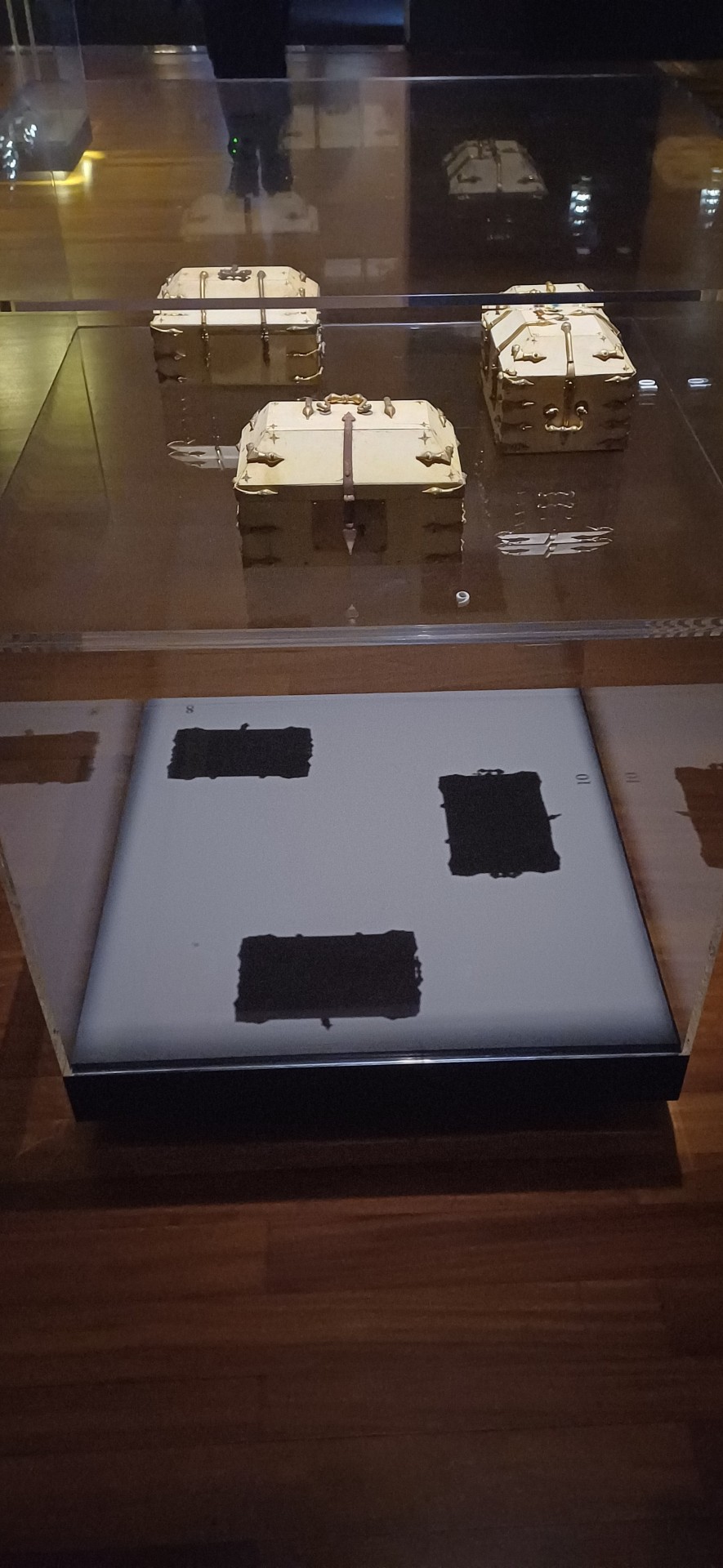

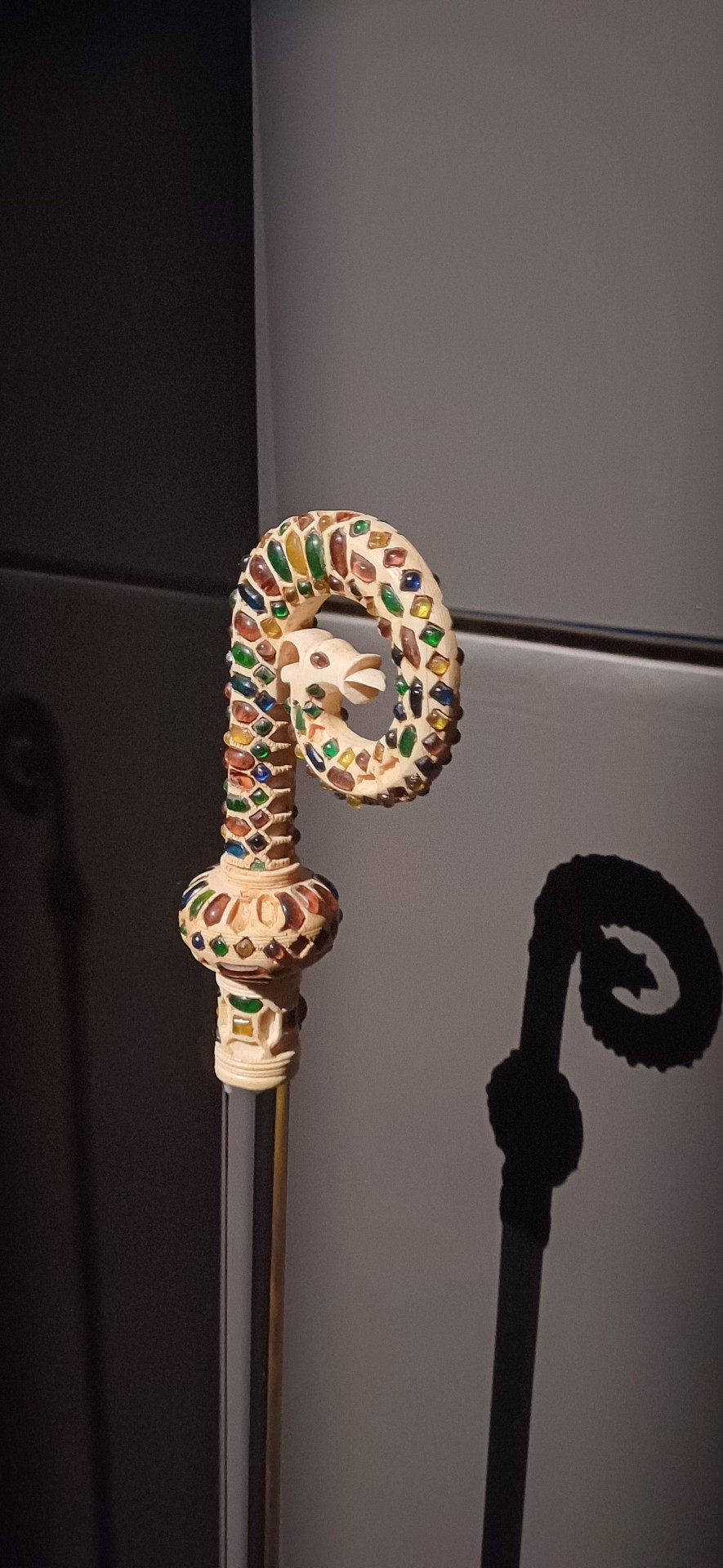

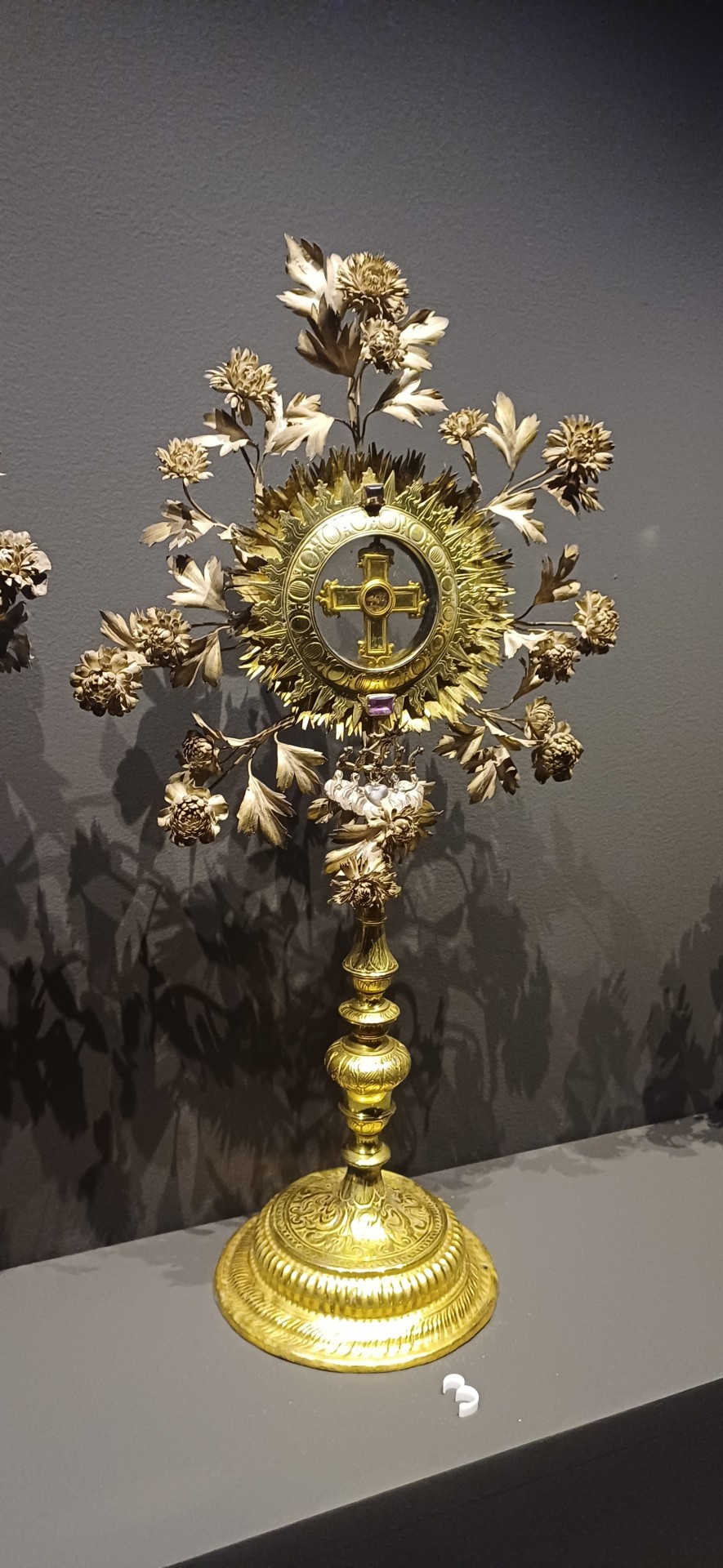
The Royal Palace or The Norman Palace of Palermo was constructed on the highest part of the city, above a Punic installation discovered in 1984 (located in the section under the Duke of Montalto Halls). During the Arab domination, the first nucleus was built between the rivers Kemonia and Papireto with characteristics that were typically defensive, that is why it was named “Qsar”, a term that in Arabic indicates more than a castle, but also a fortress for military assignments.
Some remains of the Moor civilization in Italy
2 notes
·
View notes
Text
Captain Martini in the Mediterranean
Wednesday 30th August 2023 – Arab-Norman Heritage in Palermo, Sicily
After a less-than-quiet morning on board Silver Nova, our afternoon excursion took us first by bus to the Porta Nuova, celebrating the conquest of Tunis in 1535.
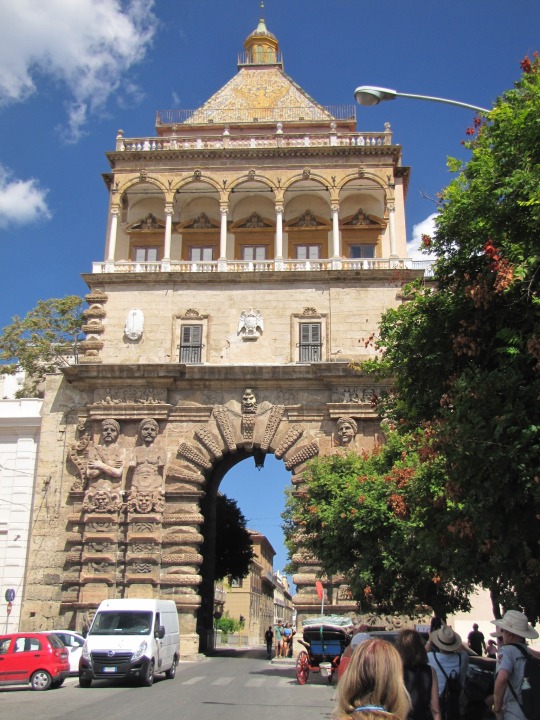
Just around the corner was the Palazzo Normanni or Royal Palace, founded in 1072 following the Norman conquest of Sicily and the oldest Royal Palace in Europe still in use – though today as Government offices.
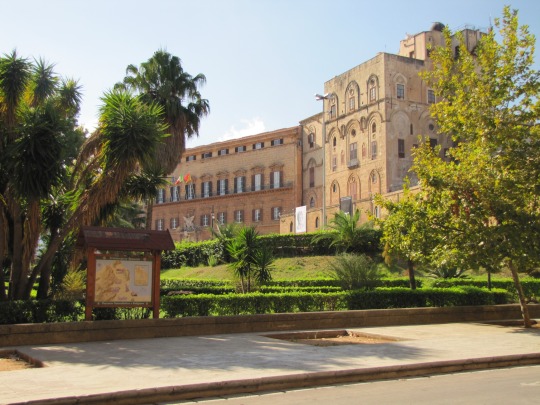
The Palace’s main attraction today though is the Palatine Chapel, commissioned by King Roger II in 1132. The decorative mosaics are absolutely stunning.
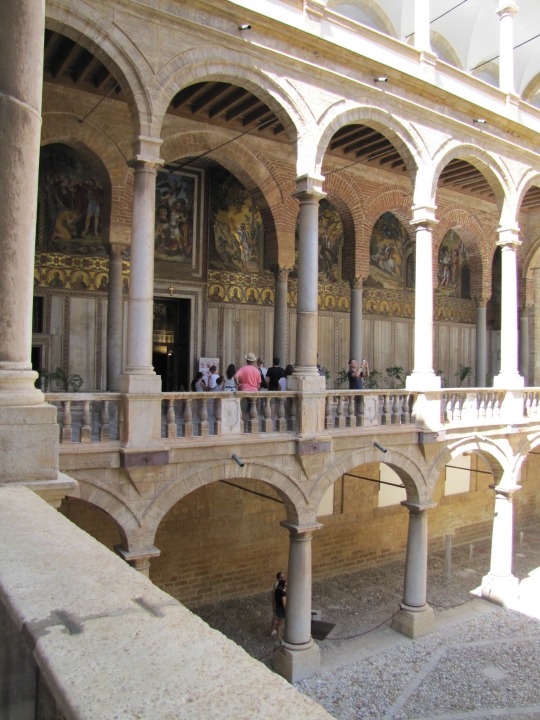
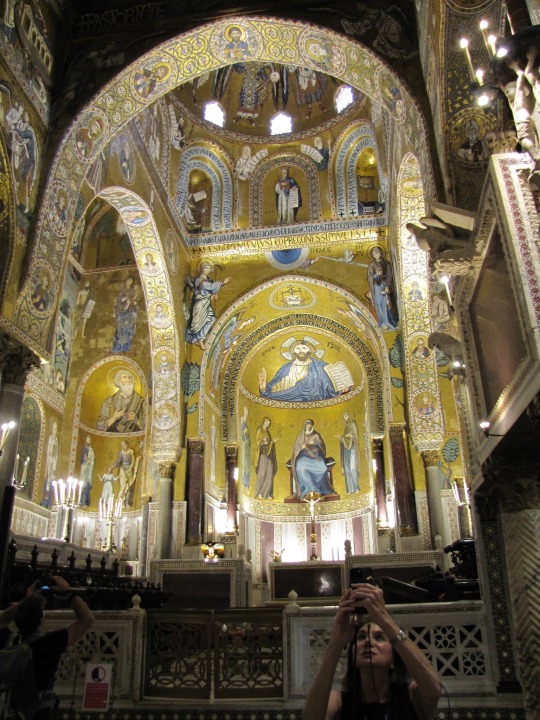
From there we travelled by bus up to the hillside town of Monreale to see the Cathedral built founded by King William II in 1172 following a vision, or so the story goes, which told him to build it.
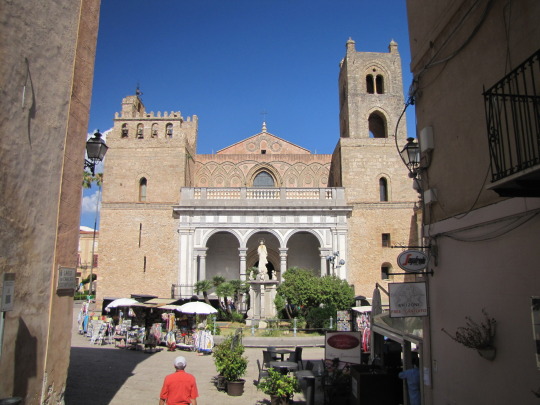
Well, at least that’s the explanation he gave at the time to explain the apparent competition with the Cathedral in Palermo – or more particularly, the then Bishop of Palermo!
I should mention here that, this same excursion to Monreale was the very first land excursion John & I did on our very first cruise back in 1983! And here are the photos to prove it….
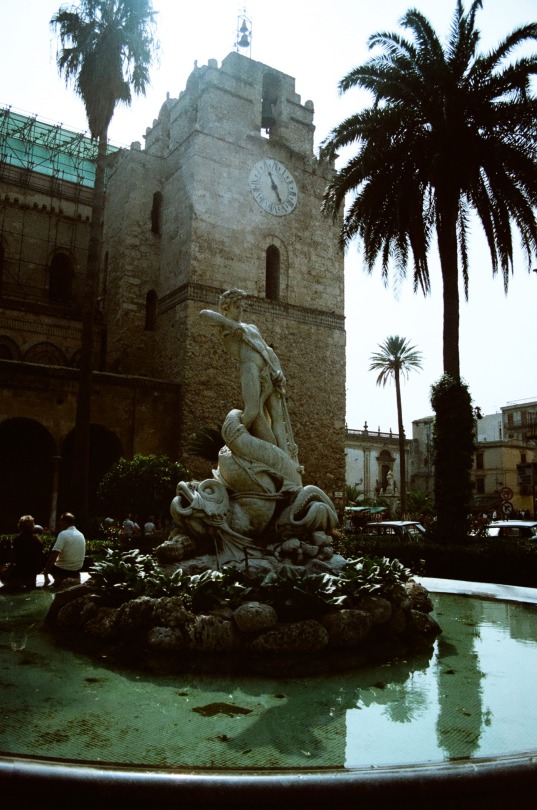
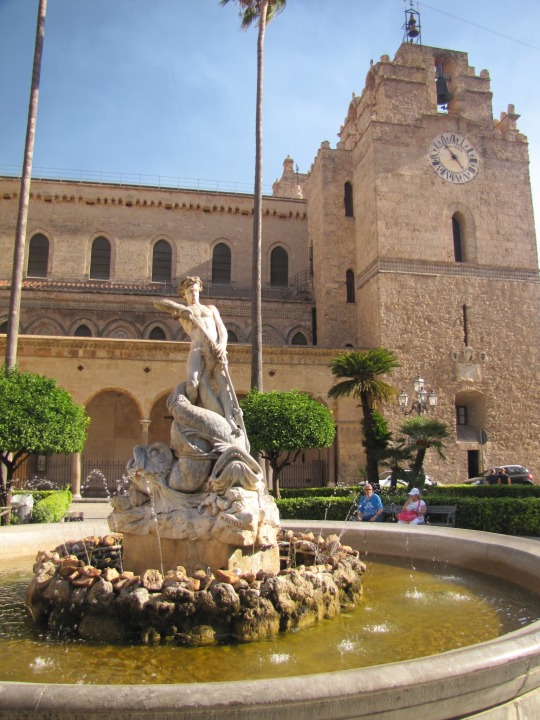
Our visit today, however, coincided with a Sicilian wedding and it was fascinating to see what was, to my eyes at least, a lesson in disorganised chaos! The public were still in the cathedral when the whole thing began and we all got to hear the organ playing the Prince of Denmark’s March as the Groom came in and then the Wedding March when the bride arrived! Amazing!
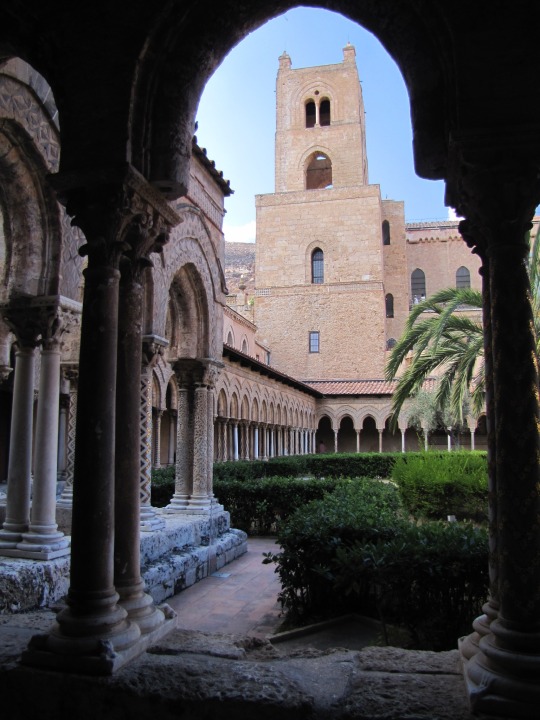
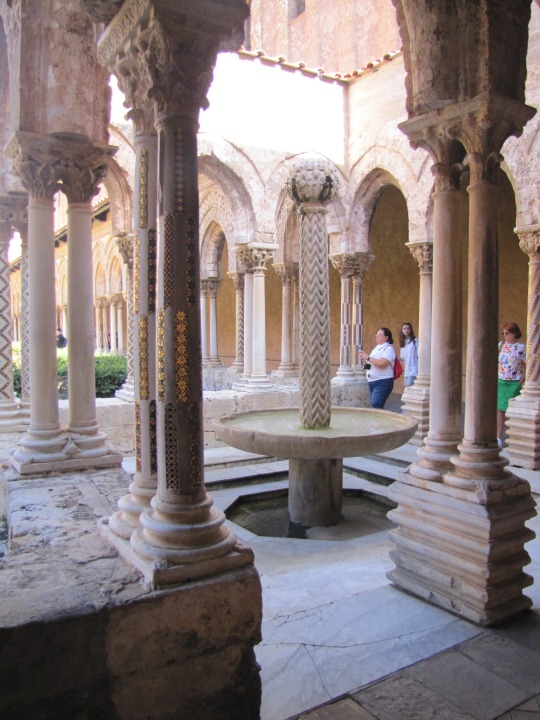
The serenity of the Monastery Cloister next door was in marked contrast. With something like 232 decorated columns and, surprisingly, not many visitors, was quite beautiful. The town sits on the hillside above Palermo and there was a great view down to the coast and the Tyrrhenian Sea beyond.
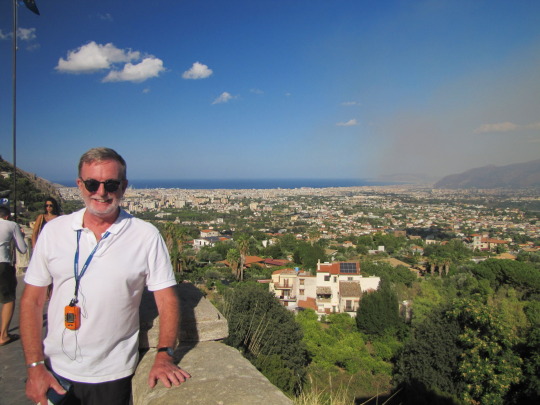
2 notes
·
View notes
Text
Yapping about my honeymoon this summer because my wife planned out my dream trip for me and I love my wife and it’s in Europe on a cruise and it’s gonna be so fun and DID I MENTION I LOVE MY WIFE :3 🩷
(Also I hope this doesn’t sound like I’m bragging or anything at all :(( I just wanna share the trip my wife and I planned :D)
Sooo right about in the middle of July we’re flying over to Barcelona, Spain!! We spend a day there and sightsee and stuff, and then the next day we get on our cruise! :)
The second day we’re just going to be at sea, but say three is when we’re in Livorno (Florence, Pisa), Italy! We plan to see the leaning tower of Pisa, visit museums, and see the Basilica of Santa Croce in Florence!
The fourth day were in Civitavecchia (Rome), Italy! We of course plan to see the colosseum, and walk around the city!
The fifth day we’re in Naples (Pompeii), Italy! This is probably going to be one of my favorite stops, because I love pizza and I know they’re gonna hate to see me coming. And, I hope we’re gonna be able to see Mount Vesuvius! :)
The sixth day (our last stop) is in Palermo (Sicily), Italy! We’re planning to see the Palermo Cathedral, and the Royal Palace and Palatine Chapel!
(On all days we have set activities/itineraries)
Then, we sail back to Barcelona on day seven. After we get off of the cruise, we hop on a train to Paris!! While in Paris, we don’t have any set plans, but we do want to see the Eiffel Tower! We stay in Paris for 2 days and 3 nights, and then we fly back to Florida into Miami and drive home from there :)
EEEEEKKK IM SO EXCITED!!! I’ll definitely take pictures to show you guys! :D

#charlotte natters 💜#honeymoon#italy#spain#france#european vacation#cruise#I’M SO EXCITED!!#i’ve said that a million times BUT I AM!!
1 note
·
View note
Text
Evento a Palermo per la lingua siciliana- vuoi partecipare?
At 4 pm on the 21st of February, there will be a conference held at the Royal Palace in Palermo for discussing practical ways of preserving and practicing the Sicilia language. AUCLIS, a confederation of 18 Sicilian language organizations, is hosting it.
This is the poster and contact info. Original post: (Sicilian) 21 frivaru, uri 16, cci sirà un cummegnu ô Palazzu Riali a Palermu pâ lingua siciliana. Si voi èssiri prisinti, fammi sapiri e ti pozzu agghiùnciri â lista dî mitati! Vulemu aviri na prisenza granni assai di juvini! (E tutti, si nun si juvini haha) (Italian) 21 febbraio, ore 16, ci sera un convegno al Palazzo Reale a Palermo per la lingua siciliana. Si vuoi essere presente, fammi sapere e ti posso aggiungere alla lista degli invitati! Vogliamo avere una presenza massiccia di giovani! (E tutti, se non sei giovane haha) Please go if you can, this is a massive milestone in the fight for the language and if you can, please record the conference. Many Sicilians who work to preserve the language live abroad and are unable to go in person, it would mean a lot to the diaspora to be able to record and share this online.
#sicilian#italy#sicily#sicilia#linguistics#languages#language stuff#italian#italia#preserving culture#culture#history#italian politics#politics#political#activism#conference#lingua italiana#lingua siciliana#spread the word#hope#hopeful#febbraio 2024#palazzo reale a palermo#palazzu riali a palermu#palaces#cities#urban#diaspora#christianity
0 notes
Text

"Porta Nuova is a monumental city gate of Palermo. It represents the entrance of the Cassaro (the main and most ancient street of the city) from Corso Calatafimi (the way to Monreale) and is located beside Palazzo dei Normanni, royal palace of Palermo."
0 notes
Text
Dear Italy... ✈
Ciao!
I decided to resume my time in Italy all in one post because I did almost the same thing in every city.
The first stop was in Venice, that I always loved and dreamed about. I enjoy all the 2 days that spend there and I'm really that this city may disappear one day.




Next, I went to Milan. I enjoyed all the cathedrals, the galleries and all the historical places. It's so pretty and different than Venice.





Two days later, in Rome, I enjoyed the great places to eat. In the four days I spend there, I went to famous places, restaurants, coffees.






My last stop in Italy was in Palermo, Sicily. I first hear about Sicily because of Cosa Nostra and I get interested to get to know the region, so I choose Palermo. I visited a lot of churches, teathers and even royal tombs.





As a Dan Brown's fan, I went to some places that appears in his books.
In Venice, i visited St. Mark's Basilica, Doge's Palace and Rialto Bridge. They appears in the book named Inferno:



I went to Santa Maria della Vittoria, Castel Sant'Angelo and the S. Maria del Popolo church in Rome, that appears in Angels & Demons:



This is it! Italy is gorgeous and now I want to learn the language and come back one day.
Next and last stop: Greece.
See ya.
XOXO, Laura <3
0 notes
Text
Teatro Massimo (Teatro Massimo Vittorio Emanuele di Palermo)
Opera house in Palermo, Italy

Teatro Massimo, Palermo. General view.
The Teatro Massimo Vittorio Emanuele is an opera house and opera company located on the Piazza Verdi in Palermo, Sicily. It was dedicated to King Victor Emanuel II. It is the biggest in Italy, and one of the largest of Europe, renowned for its perfect acoustics.
Departments: Bistrò del Teatro Massimo
Address: P.za Giuseppe Verdi, 90138 Palermo PA, Italy
Capacity: 1,387
Opened: May 16, 1897
Architects: Ernesto Basile, Giovan Battista Filippo Basile
Architectural styles: Renaissance architecture, Neoclassical architecture
Phone: +39 091 605 3580
Teatro Massimo - Wikipedia
Palermo
City in Sicily, Italy

Palermo Cathedral
Palermo is the capital of the Italian island of Sicily. The 12th-century Palermo Cathedral houses royal tombs, while the huge neoclassical Teatro Massimo is known for opera performances. Also in the center are the Palazzo dei Normanni, a royal palace started in the 9th century, and the Cappella Palatina, with Byzantine mosaics. Busy markets include the central Ballarò street market and the Vucciria, near the port.
Elevation: 14 m (46 ft)
Founded: 736 BC
Metropolitan city: Palermo (PA)
Region: Sicily
Palermo - Wikipedia

Teatro Massimo - Palermo SICILIA ITALIA 🇮🇹
Inaugurato il 16 maggio 1897, è il più grande edificio teatrale lirico d'Italia e il terzo d'Europa.
118 notes
·
View notes
Photo

Royal palace in Italy | Sicily | palermo | best tourist place in Italy | italy tamil vlogs
0 notes
Text
The Best garden city: A Comprehensive Guide to Urban Oases
Are you tired of the hustle and bustle of city life? Do you long for green spaces and fresh air? Look no further than the world's best garden cities. These urban oases combine the conveniences of city living with the tranquillity of natural beauty. This article will explore the top garden cities worldwide and discover what makes them unique.

1. Singapore: The Garden City
Singapore is known as the Garden City for a good reason. With over 300 parks and four nature reserves, this small island nation is a paradise for nature lovers. The Gardens by the Bay is a must-visit attraction, with its iconic Supertrees and Cloud Forest. The Singapore Botanic Gardens, a UNESCO World Heritage Site, is also a must-see.
2. Kyoto: A City of Zen Gardens
Kyoto is Japan's cultural capital, and it's also home to some of the most beautiful gardens in the world. From the famous Zen rock gardens of Ryoan-ji to the traditional Japanese gardens of Kinkaku-ji, Kyoto's gardens are a testament to the country's love of nature and beauty.
3. Melbourne: A City of Parks
For a good reason, Melbourne is often called Australia's garden city. The city has over 480 parks and gardens, including the Royal Botanic Gardens and the Carlton Gardens. The city's parks are perfect for picnics, jogging, or simply taking a stroll and enjoying the beauty of nature.

4. Vancouver: A City Surrounded by Nature
Vancouver is a city that's surrounded by natural beauty. The city is a paradise for nature lovers with its stunning mountains and picturesque coastline. Stanley Park is a must-visit attraction, with its seawall, beaches, and old-growth forest. The VanDusen Botanical Garden is another popular destination, with its beautiful collection of plants and flowers worldwide.
5. Curitiba: A City of Sustainability
Curitiba is a Brazilian city often cited as a model for sustainable urban development. The city's parks and green spaces are a testament to its sustainability commitment, and it is home to over 30 parks and nature reserves. The Curitiba Botanical Garden is a must-see destination, with its beautiful collection of plants worldwide.
6. Copenhagen: A City of Bicycles and Green Spaces
Copenhagen is a city famous for its bicycle culture but also a city of green spaces. The Tivoli Gardens is one of the city's most famous attractions, with its beautiful gardens and amusement park. The city is also home to the famous King's Garden and the Frederiksberg Garden, two beautiful parks perfect for picnics and relaxing.
7. Portland: A City of Roses
For a good reason, Portland, Oregon, is known as the City of Roses. The city is home to the International Rose Test Garden, where visitors can admire over 10,000 roses worldwide. The city's parks and gardens are also home to many other beautiful plants and flowers, making Portland a paradise for garden enthusiasts.
8. Munich: A City of Beer Gardens
Munich is famous for its beer gardens, but the city is also home to beautiful green spaces. The English Garden is one of the largest city parks in the world, and it's a popular destination for locals and tourists alike. The Nymphenburg Palace Gardens are another must-see attraction, with their beautiful Baroque-style gardens and impressive fountains.

9. San Francisco: A City of Golden Gardens
San Francisco is known for its iconic Golden Gate Bridge but is also home to some beautiful gardens. The San Francisco Botanical Garden is a must-visit attraction, with its impressive collection of plants worldwide. The Japanese Tea Garden is another popular destination, with its traditional Japanese garden and teahouse.
10. Buenos Aires: A City of Parks and Plazas
Buenos Aires is a city known for its vibrant culture and nightlife, but it's also home to some beautiful green spaces. The Palermo Woods is the largest park in the city, and it's a popular destination for jogging, picnics, and outdoor activities. The Rose Garden Walk in the Parque Tres de Febrero is another must-see attraction, with its beautiful collection of roses worldwide.
Conclusion
These are just a few of the world's best garden cities, each offering a unique combination of natural beauty and urban convenience. Whether you're a nature lover or simply looking for a peaceful escape from city life, these cities will surely delight and inspire you.
1 note
·
View note
Video
Cristo Pantocratore por Eugenio Sollima Por Flickr: Cristo Pantocratore nella Cappella Palatina (catino dell'abside centrale) di Palazzo dei Normanni a Palermo. © Eugenio Sollima.
#Cappella Palatina#Eugenio Sollima#Palazzo dei Normanni#Sicilia#Sicily#landmark#Italia#Italy#arte bizantina#arte#art#mosaico#mosaic#Palermo#Palazzo Reale di Palermo#Royal Palace of Palermo#Palace of the Normans#Palatine Chapel#gold#oro#Cristo#Cristo Pantocratore#Christ#Χριστὸς Παντοκράτωρ#Cappella Palatina di Palermo#mosaico di scuola bizantina#abside#Christ Pantocrator#Byzantine art#Byzantine
3 notes
·
View notes
Photo

Palermo, Sicily
By fowolf
#Palermo#Sicily#Italy#Europe#Architecture#Interior#Design#Interior design#Elegance#Palace#Royal#Travel#Travel blog
40 notes
·
View notes
Photo
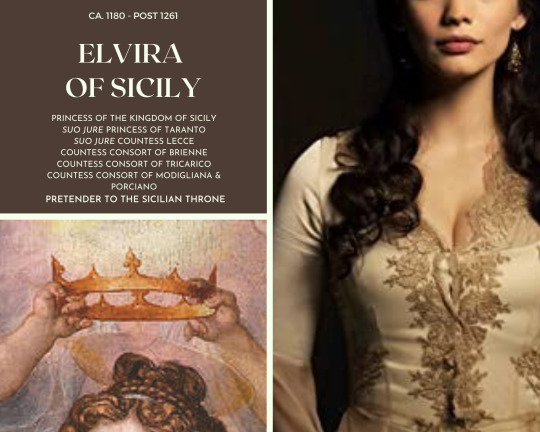
“Si vous dirons d'une damoisiele qui en Puille estoit, qui fille avoit esté le roi Tangré. Elle par le consel l'apostoile et le consel d'aucun preudome, ala en Campaigne, al conte Gautier de Braine et fist tant qu'il l'espousa. Et quant il l’ot espousée, elle l'enmena en Puille, et alerent par Rome.”
Chronique d'Ernoul et de Bernard le Trésorier, etc, p. 329
Elvira (also known as Albinia, Alberia, Maria, Albidina and Bianca) was born around 1180 most certainly in Lecce (Apulia), at that time part of the Kingdom of Sicily, ruled by the Norman House of Hauteville as the daughter of Tancredi of Lecce and his wife Sibilla of Acerra. Elvira was the eldest of four daughters, the others being Medania (or Madania), Costanza and Valdrada, the latter two would both marry two Venetian Doges. Sibilla had also given birth to two sons, Ruggero and Guglielmo.
Tancredi was the bastard son of Ruggero Duke of Apulia, eldest son of King Ruggero II of Sicily and Elvira of Castile. Given his status as an illegitimate child, when Duke Ruggero died in 1148, Tancredi couldn’t inherit the duchy (though he succeeded his father as Count of Lecce) nor was deemed fit to take his father’s place as future King, and the throne would eventually pass in 1154 to his uncle, Guglielmo I, the only surviving son of Ruggero II (nobody between the King’s elder sons, Ruggero of Apulia, Tancredi of Bari or Alfonso of Capua had, in fact, produced legitimate heirs).
Relationship between Tancredi and Guglielmo I had been turbulent, to say the least. In 1155, the Count of Lecce rebelled against his uncle and master, and because of this was imprisoned (alongside his brother, another Guglielmo). Again in 1161, Tancredi rose against Guglielmo I. The plot led to a bloody tumult that broke out in Palermo, with the Royal Palace raided by the rioters, the King and the Royal family imprisoned, important documents destroyed and the massacre of many Palace eunuchs, considered power usurpers. At some point, though, the revolt started to lose its strike, the King had to be released and, in order to be pardoned, Tancredi agreed to self-exile in Constantinople. In 1166, following Guglielmo I’s death and the accession to the throne of his son, Guglielmo II, Tancredi returned in Sicily. During the reign of his cousin Guglielmo, he proved to be a faithful subject and was awarded with the leadership of the Sicilian fleet. It is at this particular moment that Elvira was born. We do not know anything about her early years, and we can only imagine she spent her time with her mother and siblings, living in Apulia and later moving to Sicily.
The death of Guglielmo II in 1189 threw the Kingdom into a succession crisis. The King left, in fact, no direct living heir as his marriage to Joan of England hadn’t been blessed with children. Perhaps, at some point, Tancredi might have thought his childless cousin would designate him as his heir. Unfortunately for him, Guglielmo had already appointed their common aunt Costanza as his successor. In addition to being a woman, Costanza was married to Heinrich VI of Germany, son of Friedrich Barbarossa. Taking advantage of the malcontent of the Sicilians (who feared they would eventually see their country absorbed into the Hohenstaufen’s estates), and the fact that both Costanza and her husband couldn’t leave Germany at that moment (Heinrich was acting as regent since his father was at that moment busy crusading in the Holy Land) Tancredi rushed to Palermo, where he was crowned in January 18th 1190.
Roughly two months later, Richard I of England arrived in the Sicilian city of Messina. Although the official reason was to sail from there to the Holy Land, he had more pressing familiar issues to take care of. Joan, widowed Queen of Sicily as well as sister to King Richard, had been taken prisoner by Tancredi in the harem of the Castello della Zisa (Palermo) after being denied the return of her dowry. After having obtained the release of his sister, the payment of the dowry and of a compensation for himself, Richard accepted to join an alliance with Tancredi and support his rulership against Costanza’s (rightful) claim. To seal the partnership, the two Kings planned the betrothal between Arthur of Brittany (Richard’s nephew and heir) and one of Tancredi’s daughters (we do not know which one, although it could have been Elvira since she was the eldest). After the deal, and after a brief occupation of Messina, Richard of England finally sailed towards the Holy Land. Tancredi’s reign would be cut short. He died of a non specified illness on February 20th 1194. His eldest son, Ruggero, had died the year prior, while his younger son, Guglielmo, was 9-years old. Guglielmo III was King for less than a year, despite his mother’s desperate attempts to salvage her son’s throne in the capacity of Regent. Their subjects turned their back on them and welcomed the German rivals. Taking into account the hopelessness of their situation and the favourable terms of surrender that were offered them, Sibilla surrendered Palermo to Heinrich on December 4th. On Christmas Eve, Heinrich got crowned King of Sicily in Palermo’s Cathedral. The following day, Costanza gave birth to Federico, future Stupor Mundi, in the distant Jesi (in the Marche region).
If losing their Kingdom must have seemed to them a nasty blow, it was only the beginning. Right after the new King’s coronation, Guglielmo, Sibilla and the rest of the family were accused of having conspired against Heinrich. If it was true or it was just a pretext of getting rid of the last Hauteville’s direct male heir, the family was nonetheless deported to Germany. Guglielmo was incarcerated in the castle of Hohenems (currently in Austria), where he must have been mutilated (probably blinded) in order to make him unfit to pose as a threat and where he died at some point after 1198. Sibilla and her daughters were put under arrest in Hohenburg Abbey, in Alsace (France), being able to leave their gilded prison only in 1198, following the death of Heinrich Hohenstaufen (1197) and the election of Innocent III as Pope, who successfully petitioned for their release.
The former queen and her daughters then sought refuge in France, at the court of Philippe Auguste. Now, finally safe, Sibilla started looking for an eligible husband for her eldest daughter as well as Tancredi’s heir, Elvira. Since the current King of Sicily was just a child (Federico was just 4-years old and already orphan of both parents), Sibilla intended to propose Elvira (now around 18 years old) as an alternative to the little sovereign and for that the young princess needed the backup of a man (as Costanza did too).
After a meeting in Melun with the French King, a fit spouse was found for Elvira: Gautier III Earl of Brienne. Between 1199 and 1200 Elvira and Gautier married. Of course the marriage to the pretender to the Sicilian throne meant a qualitative leap for both her husband and the House of Brienne (Gautier’s younger brother, Jean, would later become King of Jerusalem and Emperor of the Latin Empire), and it shouldn’t surprise Philippe of France encouraged the married couple to leave France in order to pursue their destiny.
In 1200 Elvira, Gautier and Sibilla arrived in Rome to peruse their cause before the Pope. Unfortunately for them and despite his antipathy towards the older Hohenstaufen (who, unlike the Hauteville, had a penchant for opposing the Papacy’s power), Innocent III was Federico’s guardian. The Pope refused to support Elvira’s claims and simply recognized her rights to be styled as Princess of Taranto and Countess of Lecce. These titles had, of course, once belonged to her father and Heinrich had promised to give them back to Sibilla and her family as compensation for giving up her son’s rights and surrender peacefully. The Hohenstaufen hadn’t really kept his promise since, as we have seen, he would swiftly incarcerate his rivals and take back those lands once again. Now, Elvira was able to get back part of her father’s inheritance, but in exchange she (and her husband) had to recognize Federico as her King, thus giving up her claims to the throne once and for all.
The problem was that those promised lands had already a lord (although not the legitimate one), Roberto di Biccari, who had received the fiefs from Heinrich VI. Elvira and Gautier had to practically take them back and, for that, they needed an army. This is where we can spot Innocent’s ambivalence. He was still protecting his pupil and his rightful claims, but at the same time he planned to undermine Markward von Annweiler’s (who had reclaimed the title of Regent, with the support of Philipp of Swabia, Federico’s uncle, and represented and obstacle for the Papacy’s plans to actively rule the Kingdom during Federico’s minority) powers and for that he had planned to use the Earl of Brienne and his warfare ability. In spring 1201 Gautier and Elvira, supported by an army, entered the continental part of the Kingdom of Sicily. The skilled Frenchman defeated the Sicilian army in many occasions, occupying Teano, Presenzano, Aquino, Melfi, Montepeloso, Matera, Otranto, Brindisi, Barletta and Lecce. By the second part of 1201 Elvira is referred to as Countess of Lecce, while her rival Roberto di Biccari retained only Ostuni and the nominal title of Prince of Taranto.
Gautier kept achieving many important victories, while in Sicily Markward had managed to get his hands on the young King. Innocent then urged the Earl of Brienne and Giacomo di Andria (Innocent’s kinsman) to invade Sicily, after rewarding them with the title of Chief Justiciar of Apulia and Terra di Lavoro. Despite Markward’s death in 1202, the invasion would never take place since Gautier must have realised Innocent’s ambiguity. The Pope was, in fact, negotiating for the betrothal of Federico and the princess Costanza of Aragon and an alliance with Aragon would eventually limit the Frenchman’s influence.
Innocent III died in Anagni in 1203 and Gautier was at his deathbed when Brindisi, Otranto, Gallipoli, Matera, Barletta and many other cities revolted against him and his oppressive rulership. The Earl of Brienne died two years later, in 1205, while besieging Sarno. On June 11th he was captured in his own tent and died three days later of the wounds he had sustained during his seizing.
At that time Elvira was already pregnant and would soon give birth to posthumous son, called Gautier after his late father. According to some historians, Elvira had previously given birth to a daughter, Marguerite, who would later marry Balian Granier, Lord of Sidon. But Balian appears to have married Ide de Reyne, Gautier’s niece.
Elvira married for a second time, perhaps just a couple of months after Gautier’s death. Her second husband was Giacomo I (also known as Giovanni) Sanseverino, earl of Tricarico (according to an unknown source, this Giacomo is to be identified with Giacomo of Tricarico, married to one Mabilia, daughter of Landulfo Earl of Ceccano). Since her first husband had died in captivity, the County of Lecce and the Principate of Taranto (although hers by right) reverted back to the Hohenstaufen. Her marriage to a member of the powerful House of Sanseverino had been then a matter of necessity, a way to keep her anchored to her native land and a protection for her child and herself. Nonetheless, by marrying an Italian nobleman she stated then her intention to not return in France thus preventing her infant son, the new Earl of Brienne, to grow up in his inherited dominions, plus losing her rights to act as Regent during her son’s minority (as well as all of her ties with the House of Brienne), that role played by his uncle Jean.
The Thomas Tusci Gesta Imperatorum et Pontificum records that Giacomo and Elvira had two children, Simone and Adalita (“comitem Symonem et dominam Adalitam”), although it doesn’t specify their date of birth, nor we possess further details about their lives, except Simone might be identified with the “filium comitis Tricaricensis ” cited in the Ryccardus de Sancti Germano Chronica, who (together with other Southern Italian aristocrats like Ruggero de Aquila and Tommaso the Elder Sanseverino Earl of Caserta) rebelled against Federico II in 1223 and got incarcerated. Giacomo II of Tricarico, Lord of Serino, Solofra and Abriola, sometimes counted among Giacomo I’s children, might actually be Simone’s son and thus Giacomo I and Elvira’s grandson.
Around 1220, once again widowed, Elvira would marry for a third and last time. Her third husband (chosen by Federico II) was another Italian nobleman, Tegrimo (also known as Teugrimo or Teudegrimo) Guidi, younger son of Guido Guerra III Guidi and his second wife, Gualdrada Berti, and founder of the line of Modigliana and Porciano.
It was a lavish ceremony, with Tegrimo spending 10 thousand lire on it (a subtsantial amount which in the future, when the family would find itself in a precarious economical situation, his brothers would blame him). Federico granted Elvira the County of Lecce and Principality of Taranto as part of her dowry, although she got them back in name only. Actually, 30 years later (in 1252), Pope Innocent IV would take these lands from the Guidi (pro-imperial) to ostentatiously give them to Doge Marco Ziani, pro-papal as well as Elvira’s brother-in-law.
Elvira moved to Modigliana, where her presence is documented through the bill of sale of the villages of Larciano, Cecina, Casi and Collecchio, sold to the town of Pistoia for 6000 lire in 1226. Two years later, together with her husband, she donated two plots of land to the Church of Santa Maria di Pietrafitta. On 1231 she gifted the Abbot of San Gaudenzio of her feudal rights over a baron and his children and, on 1254, she gave her consent for the sale of Montemurlo to Firenze for 5000 lire.
Elvira and Tegrimo’s son and only child, Guido, was born shortly after 1220. A skilled man of war, he would follow his father and fight in Federico II’s Italian military campaigns. As podestà of Arezzo, he would manage to conciliate the pro imperial and pro papal factions. Following the Hohenstaufen king’s death and the resulting political change, Guido’s (as well as his family) fortunes declined and he would be forced to sell many of his castles. He would die in 1293.
As for Elvira’s firstborn, Gautier IV, as a teen, he would be sent to Outremer, at the court of his uncle Jean, King of Jerusalem since 1210. In 1221 Gautier received the title of Earl of Jaffa and Ascalon and around 1233 he married Marie of Lusignan, eldest daughter of Hugues I King of Cyprus and Alix of Champagne.
He retained his status of one of the Kingdom of Jerusalem’s most important vassals even when Federico II snatched the kingdom from Jean of Brienne. He was taken prisoner by the Muslim forces after the disastrous battle of La Forbie in 1244. Ceded to the Sultan of Egypt and taken to Cairo, he would die the same year, strangled by the guards after he had killed an emir guilty of having hit him on the face during a chess match. He would be succeeded by his firstborn Jean, and after he died childless, by his second son Hugues who, loyal partisan of Charles I of Anjou, received for his services the County of Lecce in 1266 (which, of course, was his by right). From later on until 1356, the County would be owned by the House of Brienne.
Finally, we don’t know in which exact year Elvira died, although we can suppose it happened after 1261. We only know the day, May 23th, a date recorded in the obituaries of the Monastery of Camaldoli, one of her beneficiaries, whose clergy commemorated her through annual masses in remembrance. Her husband would outlive her and die before 1270.
Sources
Bicchierai Marco, GUIDI, Guido, in Dizionario Biografico degli Italiani, vol. 61
Chronique d'Ernoul et de Bernard le Trésorier, publiée, pour la première fois, d'après les manuscrits de Bruxelles, de Paris et de Berne, avec un essai de classification des continuateurs de Guillaume de Tyr, pour la Société de l'histoire de France , p. 329
Ildefonso il San Luigi, Delizie degli eruditi toscani, vol. 8
Libro d’oro della Nobiltà Napoletana: Sanseverino
Litta Pompeo, Famiglie celebri d'Italia. Guidi di Romagna, tav. IX
Maison de Brienne
McDougall Sara, Royal Bastards: The Birth of Illegitimacy, 800–1230, p. 213-215Neapolitan Nobility
Panarelli Francesco, GUGLIELMO III d'Altavilla, re di Sicilia in Dizionario Biografico degli Italiani, vol. 60
Perry Guy, John of Brienne King of Jerusalem, Emperor of Constantinople, c. 1175-1237, p. 31-37
Pio Berardo, SIBILLA d’Aquino in Dizionario Biografico degli Italiani, vol. 92
Repetti Emanuele, Dizionario Geografico Fisico e Storico della Toscana
Sicily/Naples: Counts & Kings
Ryccardus de Sancti Germano Chronica, p. 343
de Sassenay Fernand, Les Brienne de Lecce et d’Athènes: histoire d'une des grandes familles de la féodalité française (1200-1356), p. 30
Thomas Tusci Gesta Imperatorum et Pontificum, p. 499
Wandruszka Nikolai, Un viaggio nel passato europeo – gli antenati del Marchese Antonio Amorini Bolognini (1767-1845) e sua moglie, la Contessa Marianna Ranuzzi (1771-1848)
#historicwomendaily#history#women#women in history#historical women#elvira of sicily#House of Hauteville#tancredi of sicily#sibilla of acerra#gautier iii of brienne#gautier iv of brienne#giacomo sanseverino#teugrimo guidi#guido guidi#norman swabian sicily#people of sicily#women of sicily#myedit#historyedit#house of brienne#house of sanseverino
69 notes
·
View notes
Photo
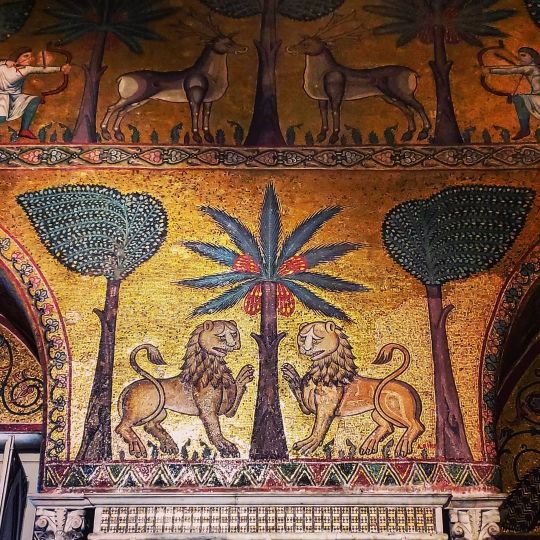
52 Reasons to Love Sicily. #3. When talking coolness factor, the city of Palermo goes to 11. It's European. It's north African. It's exotic. It's got flirtatious nightlife (La Vucciria open-air market becomes a people-watching hub after dark and in nearby Ballarò, jazz clubs take over the alleyways.). It's got high-art -- the city is home to one of Europe's largest opera houses, Teatro Massimo. Come hungry to enjoy "parts unknown" street food in Il Capo street market (in addition to the above mentioned Vucciria and Ballarò open-air wonders). Then there are ancient sites next to psychodelic baroque (Chiesa di Santa Caterina and Casa Professa, to name just two mind-blowing experiences!) next to Arab-Norman style architecture, next to Liberty Style... Oh, and royal palaces! Check out these mosaic-tiled lions (pictured) in the chambers of Roger II from the 12th century. And don't forget Castello della Zisa and then all of the baronial palazzi. Be scared, because I haven't even talked about the dead people in the Catacombe dei Cappuccini. Take my advice, one day isn't gonna do it for Palermo! #52reasonstolovesicily #experiencesicily #sicily #palermo #palazzodeinormanni #mosaics #mosaiche #lions #leoni #arabnorman #unesco #sicilia #siciliabedda #italy #italia #sicilyvacation #sicilians_world #ig_sicily #igerssicilia #instasicilia #ig_visitsicily #Sicilia_PhotoGroup #smallgrouptours #traveltogether #authenticsicily #smallgrouptoursitaly #whatsicilyis #viverlasicilia #sicilytour (at Palermo, Italy) https://www.instagram.com/p/CNbokZ4FMro/?igshid=10g7avxccbxqk
#3#52reasonstolovesicily#experiencesicily#sicily#palermo#palazzodeinormanni#mosaics#mosaiche#lions#leoni#arabnorman#unesco#sicilia#siciliabedda#italy#italia#sicilyvacation#sicilians_world#ig_sicily#igerssicilia#instasicilia#ig_visitsicily#sicilia_photogroup#smallgrouptours#traveltogether#authenticsicily#smallgrouptoursitaly#whatsicilyis#viverlasicilia#sicilytour
46 notes
·
View notes